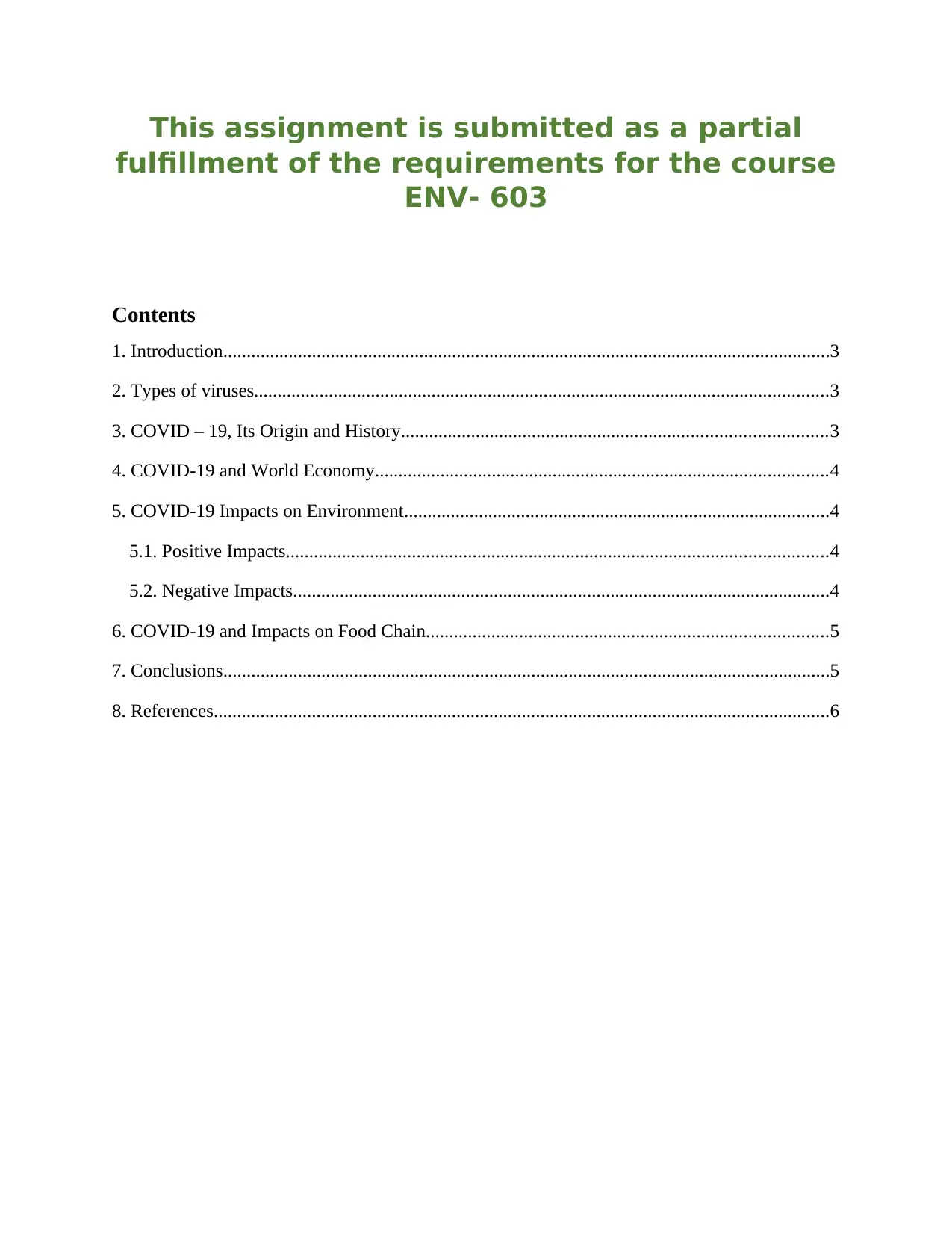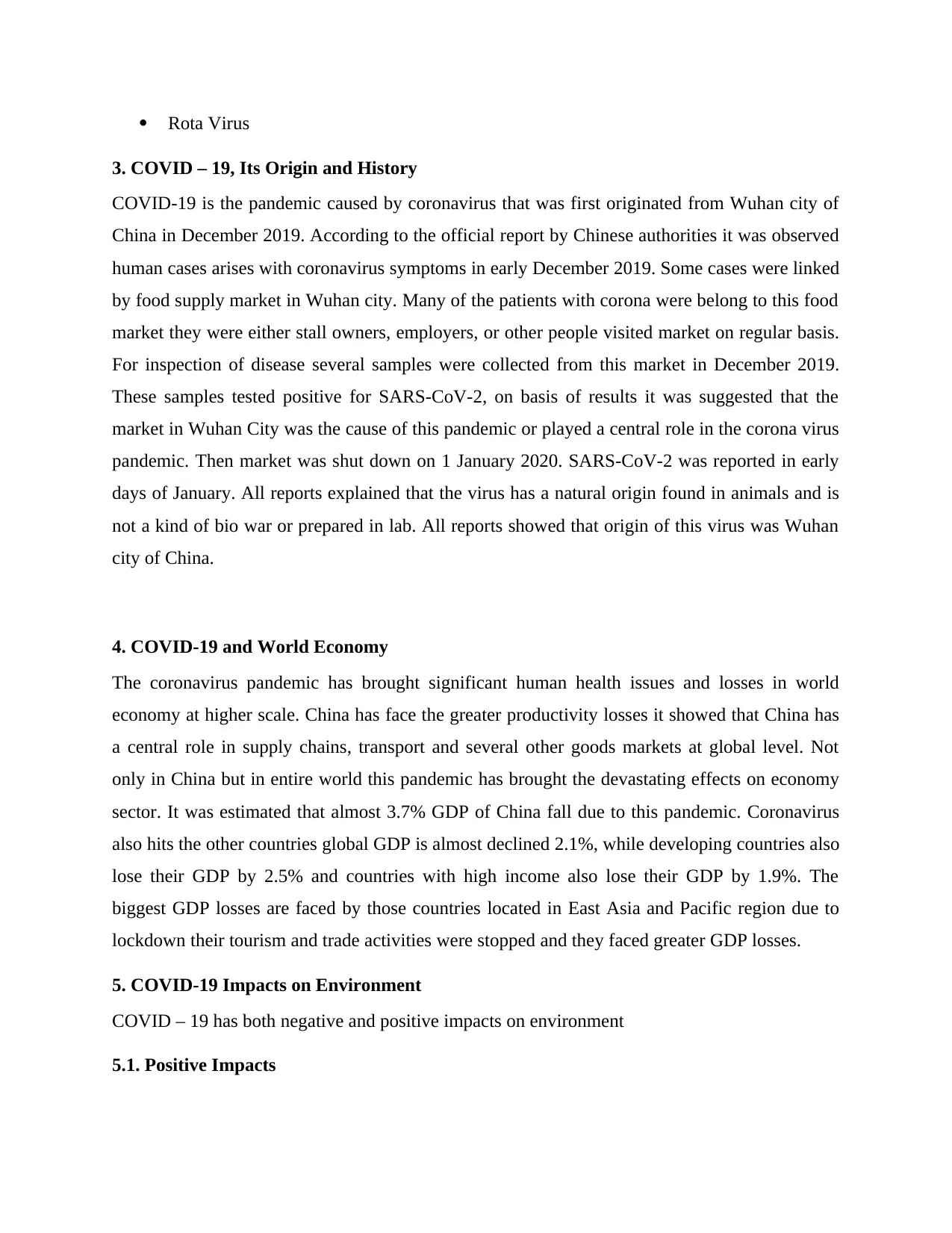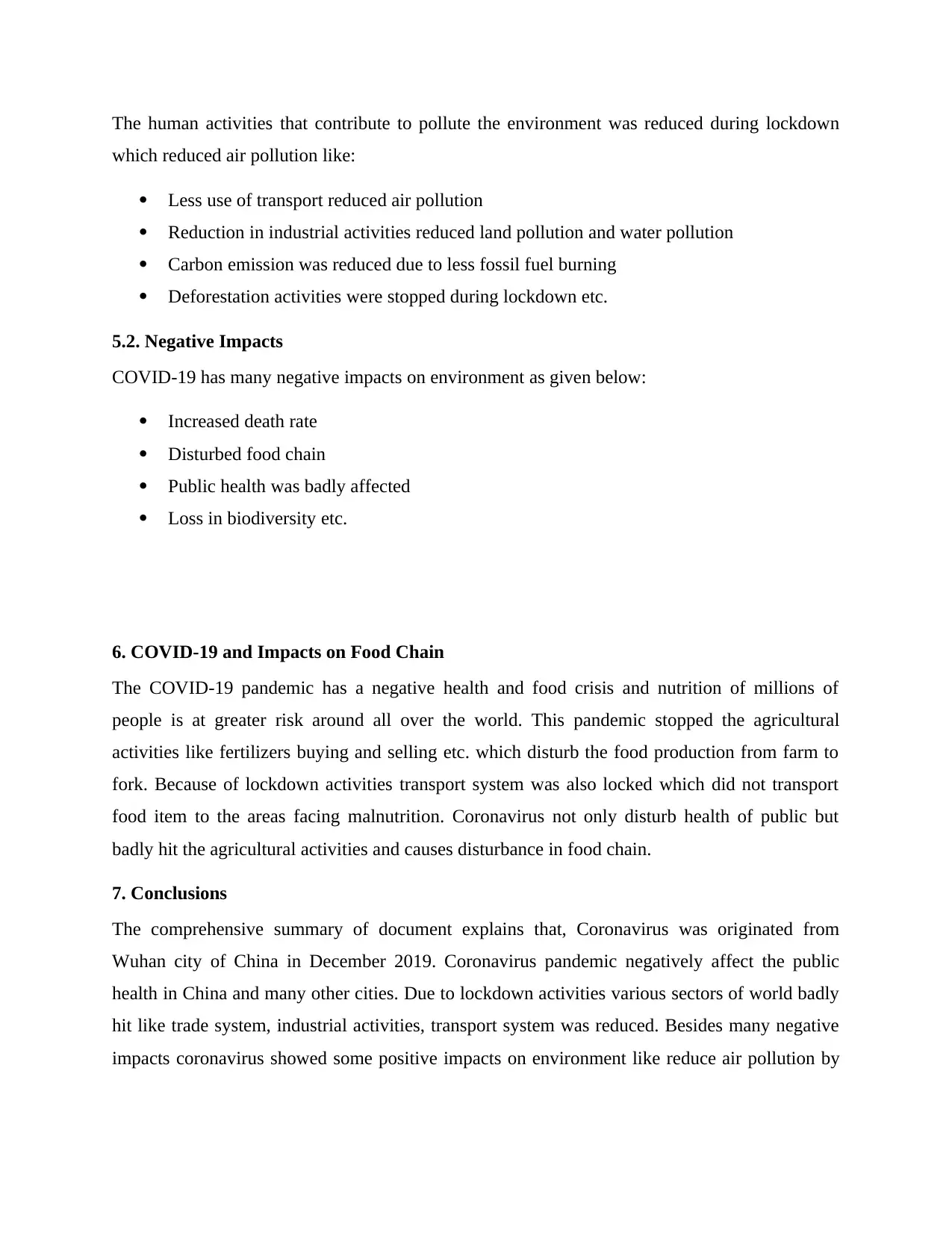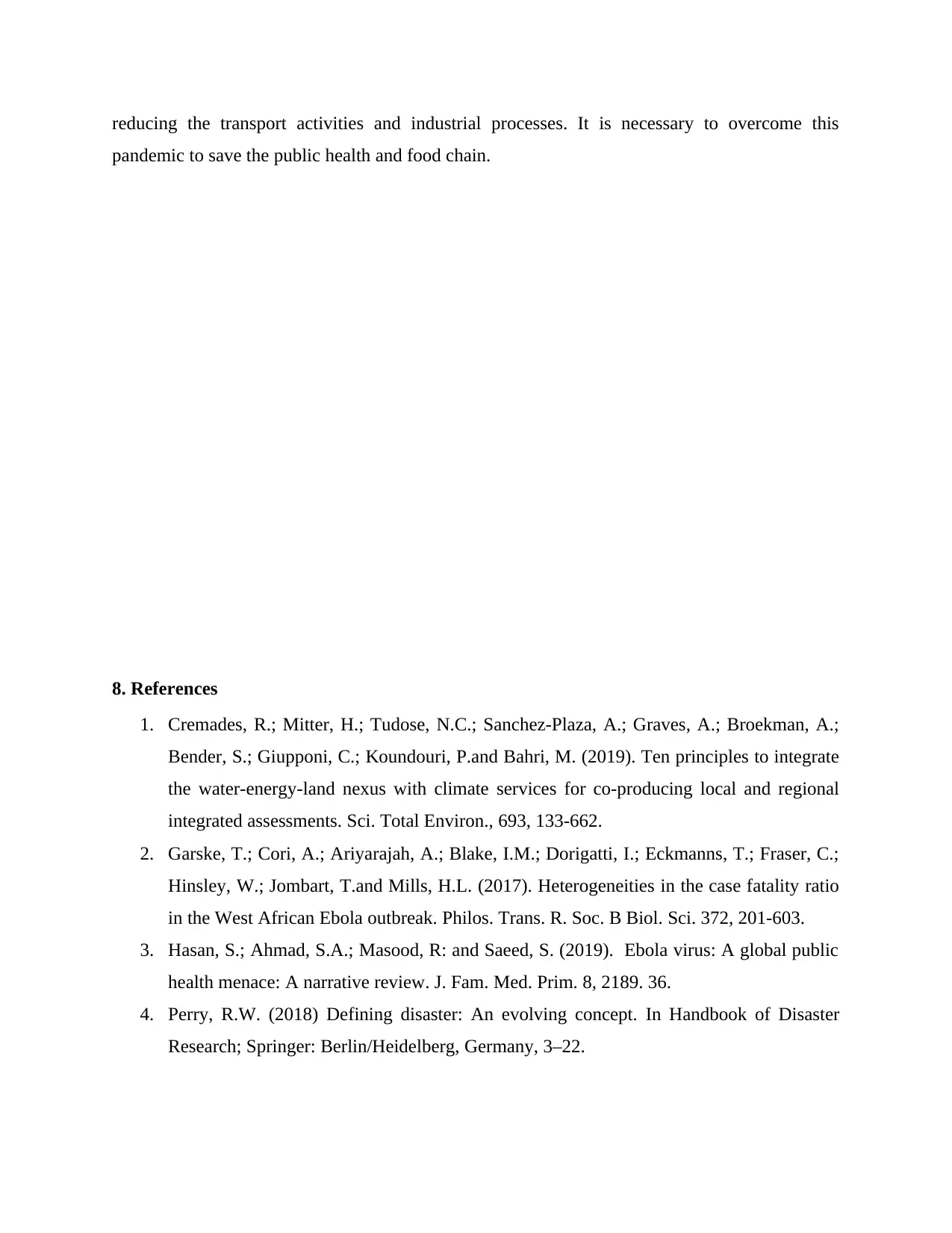COMSATS University: COVID-19's Impact on Food Chain & Environment
VerifiedAdded on 2021/03/25
|6
|1148
|78
Report
AI Summary
This report, submitted to COMSATS University Islamabad, Vehari Campus, by Hina Razzaq, examines the multifaceted impacts of the COVID-19 pandemic on both the environment and the global food chain. The report begins with an introduction to viruses, including a classification of different types and an overview of the origin and history of COVID-19, tracing its emergence from Wuhan, China. It then delves into the economic consequences of the pandemic, highlighting significant GDP losses worldwide. The core of the report focuses on environmental impacts, delineating both positive effects like reduced pollution due to decreased human activity and negative impacts such as increased death rates and biodiversity loss. Furthermore, the report analyzes the pandemic's disruption of the food chain, addressing challenges in agricultural activities and transport systems. The conclusion emphasizes the need to overcome the pandemic to safeguard public health and the food supply, supported by references to relevant scientific literature.

COMSATS University Islamabad, Vehari
Campus
Department of Environmental Sciences
Assignment No. 02
Topic:
Effects of COVID – 19 on Food Chain and
Environment in the World.
Submitted to: Dr. Mohkum
Hammad
Submitted by: Hina Razzaq
(SP20-RES-019)
MS-Environmental
Science
Semester 2
Date of Submission: 27.10.2020
Campus
Department of Environmental Sciences
Assignment No. 02
Topic:
Effects of COVID – 19 on Food Chain and
Environment in the World.
Submitted to: Dr. Mohkum
Hammad
Submitted by: Hina Razzaq
(SP20-RES-019)
MS-Environmental
Science
Semester 2
Date of Submission: 27.10.2020
Paraphrase This Document
Need a fresh take? Get an instant paraphrase of this document with our AI Paraphraser

This assignment is submitted as a partial
fulfillment of the requirements for the course
ENV- 603
Contents
1. Introduction..................................................................................................................................3
2. Types of viruses...........................................................................................................................3
3. COVID – 19, Its Origin and History...........................................................................................3
4. COVID-19 and World Economy.................................................................................................4
5. COVID-19 Impacts on Environment...........................................................................................4
5.1. Positive Impacts....................................................................................................................4
5.2. Negative Impacts...................................................................................................................4
6. COVID-19 and Impacts on Food Chain......................................................................................5
7. Conclusions..................................................................................................................................5
8. References....................................................................................................................................6
fulfillment of the requirements for the course
ENV- 603
Contents
1. Introduction..................................................................................................................................3
2. Types of viruses...........................................................................................................................3
3. COVID – 19, Its Origin and History...........................................................................................3
4. COVID-19 and World Economy.................................................................................................4
5. COVID-19 Impacts on Environment...........................................................................................4
5.1. Positive Impacts....................................................................................................................4
5.2. Negative Impacts...................................................................................................................4
6. COVID-19 and Impacts on Food Chain......................................................................................5
7. Conclusions..................................................................................................................................5
8. References....................................................................................................................................6

1. Introduction
Viruses are submicroscopic organisms that are pathogens and lives in human body for their
replication. All viruses are parasites and causes different diseases in human being. They
transmitted in human body through blood. Virology is the sub branch of microbiology in which
viruses are studied. Viruses are present in everywhere in environment they not only infect human
but also infects the plants and living organisms.
2. Types of viruses
There are several kind of viruses that causes diseases in humans like as:
Corona Virus
Ebola Virus
Marburg Virus
Hanta Virus
Influenza Virus
Dengue Virus
Viruses are submicroscopic organisms that are pathogens and lives in human body for their
replication. All viruses are parasites and causes different diseases in human being. They
transmitted in human body through blood. Virology is the sub branch of microbiology in which
viruses are studied. Viruses are present in everywhere in environment they not only infect human
but also infects the plants and living organisms.
2. Types of viruses
There are several kind of viruses that causes diseases in humans like as:
Corona Virus
Ebola Virus
Marburg Virus
Hanta Virus
Influenza Virus
Dengue Virus
⊘ This is a preview!⊘
Do you want full access?
Subscribe today to unlock all pages.

Trusted by 1+ million students worldwide

Rota Virus
3. COVID – 19, Its Origin and History
COVID-19 is the pandemic caused by coronavirus that was first originated from Wuhan city of
China in December 2019. According to the official report by Chinese authorities it was observed
human cases arises with coronavirus symptoms in early December 2019. Some cases were linked
by food supply market in Wuhan city. Many of the patients with corona were belong to this food
market they were either stall owners, employers, or other people visited market on regular basis.
For inspection of disease several samples were collected from this market in December 2019.
These samples tested positive for SARS-CoV-2, on basis of results it was suggested that the
market in Wuhan City was the cause of this pandemic or played a central role in the corona virus
pandemic. Then market was shut down on 1 January 2020. SARS-CoV-2 was reported in early
days of January. All reports explained that the virus has a natural origin found in animals and is
not a kind of bio war or prepared in lab. All reports showed that origin of this virus was Wuhan
city of China.
4. COVID-19 and World Economy
The coronavirus pandemic has brought significant human health issues and losses in world
economy at higher scale. China has face the greater productivity losses it showed that China has
a central role in supply chains, transport and several other goods markets at global level. Not
only in China but in entire world this pandemic has brought the devastating effects on economy
sector. It was estimated that almost 3.7% GDP of China fall due to this pandemic. Coronavirus
also hits the other countries global GDP is almost declined 2.1%, while developing countries also
lose their GDP by 2.5% and countries with high income also lose their GDP by 1.9%. The
biggest GDP losses are faced by those countries located in East Asia and Pacific region due to
lockdown their tourism and trade activities were stopped and they faced greater GDP losses.
5. COVID-19 Impacts on Environment
COVID – 19 has both negative and positive impacts on environment
5.1. Positive Impacts
3. COVID – 19, Its Origin and History
COVID-19 is the pandemic caused by coronavirus that was first originated from Wuhan city of
China in December 2019. According to the official report by Chinese authorities it was observed
human cases arises with coronavirus symptoms in early December 2019. Some cases were linked
by food supply market in Wuhan city. Many of the patients with corona were belong to this food
market they were either stall owners, employers, or other people visited market on regular basis.
For inspection of disease several samples were collected from this market in December 2019.
These samples tested positive for SARS-CoV-2, on basis of results it was suggested that the
market in Wuhan City was the cause of this pandemic or played a central role in the corona virus
pandemic. Then market was shut down on 1 January 2020. SARS-CoV-2 was reported in early
days of January. All reports explained that the virus has a natural origin found in animals and is
not a kind of bio war or prepared in lab. All reports showed that origin of this virus was Wuhan
city of China.
4. COVID-19 and World Economy
The coronavirus pandemic has brought significant human health issues and losses in world
economy at higher scale. China has face the greater productivity losses it showed that China has
a central role in supply chains, transport and several other goods markets at global level. Not
only in China but in entire world this pandemic has brought the devastating effects on economy
sector. It was estimated that almost 3.7% GDP of China fall due to this pandemic. Coronavirus
also hits the other countries global GDP is almost declined 2.1%, while developing countries also
lose their GDP by 2.5% and countries with high income also lose their GDP by 1.9%. The
biggest GDP losses are faced by those countries located in East Asia and Pacific region due to
lockdown their tourism and trade activities were stopped and they faced greater GDP losses.
5. COVID-19 Impacts on Environment
COVID – 19 has both negative and positive impacts on environment
5.1. Positive Impacts
Paraphrase This Document
Need a fresh take? Get an instant paraphrase of this document with our AI Paraphraser

The human activities that contribute to pollute the environment was reduced during lockdown
which reduced air pollution like:
Less use of transport reduced air pollution
Reduction in industrial activities reduced land pollution and water pollution
Carbon emission was reduced due to less fossil fuel burning
Deforestation activities were stopped during lockdown etc.
5.2. Negative Impacts
COVID-19 has many negative impacts on environment as given below:
Increased death rate
Disturbed food chain
Public health was badly affected
Loss in biodiversity etc.
6. COVID-19 and Impacts on Food Chain
The COVID-19 pandemic has a negative health and food crisis and nutrition of millions of
people is at greater risk around all over the world. This pandemic stopped the agricultural
activities like fertilizers buying and selling etc. which disturb the food production from farm to
fork. Because of lockdown activities transport system was also locked which did not transport
food item to the areas facing malnutrition. Coronavirus not only disturb health of public but
badly hit the agricultural activities and causes disturbance in food chain.
7. Conclusions
The comprehensive summary of document explains that, Coronavirus was originated from
Wuhan city of China in December 2019. Coronavirus pandemic negatively affect the public
health in China and many other cities. Due to lockdown activities various sectors of world badly
hit like trade system, industrial activities, transport system was reduced. Besides many negative
impacts coronavirus showed some positive impacts on environment like reduce air pollution by
which reduced air pollution like:
Less use of transport reduced air pollution
Reduction in industrial activities reduced land pollution and water pollution
Carbon emission was reduced due to less fossil fuel burning
Deforestation activities were stopped during lockdown etc.
5.2. Negative Impacts
COVID-19 has many negative impacts on environment as given below:
Increased death rate
Disturbed food chain
Public health was badly affected
Loss in biodiversity etc.
6. COVID-19 and Impacts on Food Chain
The COVID-19 pandemic has a negative health and food crisis and nutrition of millions of
people is at greater risk around all over the world. This pandemic stopped the agricultural
activities like fertilizers buying and selling etc. which disturb the food production from farm to
fork. Because of lockdown activities transport system was also locked which did not transport
food item to the areas facing malnutrition. Coronavirus not only disturb health of public but
badly hit the agricultural activities and causes disturbance in food chain.
7. Conclusions
The comprehensive summary of document explains that, Coronavirus was originated from
Wuhan city of China in December 2019. Coronavirus pandemic negatively affect the public
health in China and many other cities. Due to lockdown activities various sectors of world badly
hit like trade system, industrial activities, transport system was reduced. Besides many negative
impacts coronavirus showed some positive impacts on environment like reduce air pollution by

reducing the transport activities and industrial processes. It is necessary to overcome this
pandemic to save the public health and food chain.
8. References
1. Cremades, R.; Mitter, H.; Tudose, N.C.; Sanchez-Plaza, A.; Graves, A.; Broekman, A.;
Bender, S.; Giupponi, C.; Koundouri, P.and Bahri, M. (2019). Ten principles to integrate
the water-energy-land nexus with climate services for co-producing local and regional
integrated assessments. Sci. Total Environ., 693, 133-662.
2. Garske, T.; Cori, A.; Ariyarajah, A.; Blake, I.M.; Dorigatti, I.; Eckmanns, T.; Fraser, C.;
Hinsley, W.; Jombart, T.and Mills, H.L. (2017). Heterogeneities in the case fatality ratio
in the West African Ebola outbreak. Philos. Trans. R. Soc. B Biol. Sci. 372, 201-603.
3. Hasan, S.; Ahmad, S.A.; Masood, R: and Saeed, S. (2019). Ebola virus: A global public
health menace: A narrative review. J. Fam. Med. Prim. 8, 2189. 36.
4. Perry, R.W. (2018) Defining disaster: An evolving concept. In Handbook of Disaster
Research; Springer: Berlin/Heidelberg, Germany, 3–22.
pandemic to save the public health and food chain.
8. References
1. Cremades, R.; Mitter, H.; Tudose, N.C.; Sanchez-Plaza, A.; Graves, A.; Broekman, A.;
Bender, S.; Giupponi, C.; Koundouri, P.and Bahri, M. (2019). Ten principles to integrate
the water-energy-land nexus with climate services for co-producing local and regional
integrated assessments. Sci. Total Environ., 693, 133-662.
2. Garske, T.; Cori, A.; Ariyarajah, A.; Blake, I.M.; Dorigatti, I.; Eckmanns, T.; Fraser, C.;
Hinsley, W.; Jombart, T.and Mills, H.L. (2017). Heterogeneities in the case fatality ratio
in the West African Ebola outbreak. Philos. Trans. R. Soc. B Biol. Sci. 372, 201-603.
3. Hasan, S.; Ahmad, S.A.; Masood, R: and Saeed, S. (2019). Ebola virus: A global public
health menace: A narrative review. J. Fam. Med. Prim. 8, 2189. 36.
4. Perry, R.W. (2018) Defining disaster: An evolving concept. In Handbook of Disaster
Research; Springer: Berlin/Heidelberg, Germany, 3–22.
⊘ This is a preview!⊘
Do you want full access?
Subscribe today to unlock all pages.

Trusted by 1+ million students worldwide
1 out of 6
Related Documents
Your All-in-One AI-Powered Toolkit for Academic Success.
+13062052269
info@desklib.com
Available 24*7 on WhatsApp / Email
![[object Object]](/_next/static/media/star-bottom.7253800d.svg)
Unlock your academic potential
Copyright © 2020–2025 A2Z Services. All Rights Reserved. Developed and managed by ZUCOL.




